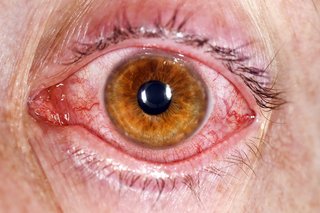When should I see a doctor about conjunctivitis (red or pink eye)?
Can I treat conjunctivitis (red or pink eye) myself? Yes, often you can. But if does not get better soon, you need to see a doctor. Some background first.
What is conjunctivitis (red or pink eye)?
Conjunctivitis is an eye condition usually caused by infection or allergies. It usually lasts under two weeks, and often gets better with no treatment.
What causes conjunctivitis?
Conjunctivitis – also known as red or pink eye – is an inflammation of the transparent lining (conjunctiva) of your eyelids and part of your eyeballs. It has several possible causes, including: bacterial or viral infection, an allergic reaction to pollen, or a result of chemical irritants (smoke, chlorine, lens solution, etc.).
Tell me more about the treatment of conjunctivitis (red or pink eye) and when to see a doctor.
What are the symptoms of conjunctivitis?
It usually affects both eyes and makes them:
- Red
- Burn or feel gritty
- Produce pus that sticks to lashes
- Itch
- Water.
 Conjunctivitis
Conjunctivitis

These symptoms may last a few hours to two weeks.
Because conjunctivitis is an inflammation of the small blood vessels in the conjunctiva, the whites of your eyes will appear pink or red. When you wake up, your eyelids may be half stuck together or shut, but your vision should be nearly normal.
Characteristically the iris (coloured bit of the eye) is normal, as is the eyesight, and there is little eye pain. If that is not the case, the diagnosis may be different and you should seek medical help ASAP.
Can conjunctivitis spread?
Yes. As viral conjunctivitis is extremely contagious, make sure you do not have contact with the affected person’s eyes. The infection can easily be passed via keyboards, doorknobs, make-up, pens, gym equipment, and a vast number of other items. If you are with someone with it, keep your distance, wash your hands regularly, and avoid touching your eyes.
Treatment
Bacterial cases may need antibiotic eye drops (e.g. 1% chloramphenicol). You can get that from a pharmacy. Viral conjunctivitis clears up on its own, and allergic reactions can be treated with various types of eye drops. Here are some general tips:
- Wash your hands frequently to prevent spreading an existing infection to your other eye, and to other people. And don’t rub your eyes
- Use a cool wet washcloth to soak off any crusting, and a warm or cool compress to reduce discomfort
- Don’t use make-up, especially eye make-up
- Wash any clothing that may be contaminated, including towels and pillowcases. Try to use clean towels and pillowcases everyday
- Avoid wearing contact lenses and discard current lenses
- If eye drops are prescribed, place drop in pocket formed by pulling down lower lid.
Note. If the infection does not start to get better in 3 days, or you lose vision or have extreme eye pain, see your GP (you need to be examined) or go to the nearest A&E with an ‘eye casualty’ soon. Check it has one, before you go.
Summary
We have described when should I see a doctor about conjunctivitis (red or pink eye). We hope you understand it better now.
Last Reviewed on 1 April 2024
